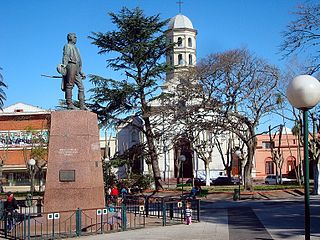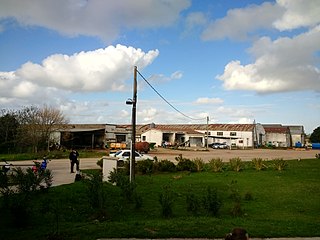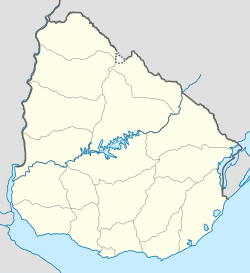
Treinta y Tres is the capital city of the Treinta y Tres Department in eastern Uruguay. It is known for its role in the development of folk music.

Lavalleja is a department of Uruguay. Its capital is Minas. It is located in the southeast of the country, bordered to the north by the department of Treinta y Tres to the east with Rocha, to the south with Canelones and Maldonado, and to the west to Florida.
Rivera Department is a department of the northern region of Uruguay. It has an area of 9,370 km2 (3,620 sq mi) and a population of 103,493. Its capital is the city of Rivera. It borders Brazil to the north and east, Cerro Largo Department to the southeast, Tacuarembó Department to the south and west and Salto Department to the northwest.
Treinta y Tres is a department of Uruguay. Its capital is Treinta y Tres. It is located in the east of the country, bordering the departments of Cerro Largo to the north, Durazno and Florida to the west, Lavalleja and Rocha to the south, while to its east is the lake Laguna Merín separating it from the southernmost end of Brazil. With a total population of 50,504, it is the second-least populated department in Uruguay and the third-least densely populated, behind Durazno and Flores.

Pan de Azúcar is a city in the southwest of the Maldonado Department in Uruguay. It takes its name from a nearby hill, topped by a huge cross.
La Floresta is a city and resort on the Costa de Oro of the Canelones Department in Uruguay.

Pando is a city in the Canelones Department of Uruguay. It is an important commercial and industrial centre which has become part of the wider Montevideo metropolitan area.

Tarariras, is a small city in the south of the Colonia Department of southern Uruguay.
Sauce is a small city and municipality in the Canelones Department of southern Uruguay.
Tupambaé is a village (pueblo) in the Cerro Largo Department of eastern Uruguay.

Cerro Chato is a town in central Uruguay that is divided in three parts belonging to Durazno Department, Florida Department, and Treinta y Tres Department.

José Pedro Varela is a small city in the north of Lavalleja Department of southeastern Uruguay. It is named after the sociologist and politician José Pedro Varela.
Minas de Corrales is a town in the Rivera Department of northeastern Uruguay.
Cebollatí is a village in the Rocha Department of eastern Uruguay. It is the northernmost settlement of the department.
Libertad is a small city in the San José Department of southern Uruguay. Its main commercial street is 25 de Agosto and its central square is Plaza Treinta y Tres Orientales.

General Enrique Martínez, also known as La Charqueada, is a village in the Treinta y Tres Department of eastern Uruguay.
Santa Clara de Olimar is a small town in Treinta y Tres Department in eastern Uruguay.

Route 8 is a national route of Uruguay. In 1975, it was assigned the name Brigadier General Juan Antonio Lavalleja, a national hero of Uruguay. It connects Montevideo with Aceguá in the northeast.

Estación Rincón or Rincón is a village in the Treinta y Tres Department of Uruguay.
Villa Sara is a suburb of Treinta y Tres, capital city of the Treinta y Tres Department in eastern Uruguay.














